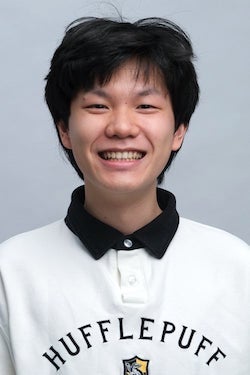Undergraduate Research
Haoyuan Gao ’24
OUR Featured Researcher: Haoyuan Gao ’24

Haoyuan Gao (he/him) is a Biology and Neuroscience major conducting mentored research under Professor Christopher Howard. His project is titled “Characterizing striatal patch-dopamine interactions in freely-moving mice".
Please describe your project:
The ability to update behaviors based on outcome from the environment is a critical brain function that can lead to great evolutionary benefits. Central to this is the striatum, a brain region responsible for selecting actions and a major target of dopamine, the neurotransmitter that drives learning about outcomes. The striatum has many different types of neurons, and in particular, one cell type called “striatal patches” have remained enigmatic, despite being discovered for over 50 years. What is known is that patches provide the only direct inhibitory feedback from the striatum to the dopamine neurons, which means they could be essential in reinforcement learning. I aim to characterize interactions of dopamine and patch neurons in freely-moving mice, which will provide novel insights into how animals regulate and update ongoing behaviors.
A brief summary (the elevator speech) of your research project:
The striatum is a brain region that facilitates learning about rewards, and I am investigating a unique cell type in the striatum called patches that may be a master regulator of dopamine release. To do this, I’m recording simultaneous fluorescent signals from the brain that indicate patch activity and dopamine level with fiber optics, based on which we can examine their correlations. This work will provide important insight into how patch and dopamine systems that are key to behavioral regulation coordinate their activity to modify ongoing actions.
Why is your research important?
The striatal patches have been categorized for a long time, while this cell type still remains mysterious in the sense of its function and interactions with other neurons. This research will explore how the patches work with other cells and how animals regulate and update behaviors, which knowledge may contribute to the field of Parkinson’s and Huntington’s diseases.
What does the process of doing your research look like?
My project relies on a new recording technique called fiber photometry, which allows simultaneous measurement of the real-time activity of neuronal pathways in freely-moving animals. I record fluorescent signals from animals moving in an open field and then analyze the data. In addition, I perform brain surgeries with viral injections and fiber optic implantations. I also did a lot of immunochemistry and imaging under fluorescent and confocal microscopy.
What knowledge has your research contributed to your field?
I am still at an early stage in my project. However, this project is based on the previous finding from the Howard lab that activation of patches via optogenetics is sufficient to suppress dopamine release in anesthetized mice, and I am trying to better explore the topic of patch-dopamine interactions in freely-moving mice, which has not been done in the field.
In what ways have you showcased your research?
I presented my poster at the 2022 Midwest Great Lakes Undergraduate Research Symposium in Neuroscience (mGluRs). I also presented at the OSRI Summer Research Symposium.
How did you get involved in research?
I have always been fascinated by the idea of how scientists perform experimental research to fulfill their curiosities and to answer the unknown. After taking introductory-level Neuroscience classes, I really want to have some hands-on experience to further explore the concepts we covered in the lecture. Furthermore, I want to pursue a PhD in Biology or Neuroscience, and undergraduate research experience will better prepare me for my future career path.
What is your favorite aspect of the research process?
What interested me the most was solving arisen issues with a detective mindset. I am still at an early stage in my project and spent a lot of time trying to get familiar with the methodology during the summer, which involves making many decisions about the next steps.
How has working with your mentor impacted the development of your research project? How has it impacted you as a researcher?
Prof. Howard has provided a lot of support but, at the same time, is great at cultivating the independence of his mentees, which is a crucial quality for researchers. I got the opportunity to analyze the situation and make decisions myself instead of having him decide the plan for me.
How has the research you’ve conducted contributed to your professional or academic development?
My research project has taught me how to think as a scientist and provided me with a lot of hands-on experience in the lab. It made me more certain about continuing the research path.
What advice would you give to a younger student wanting to get involved in research in your field?
The most important quality of a researcher, in my mind, is to remain curious and always ask questions. Although it may sound scary, the most crucial step to getting involved in research is to reach out to professors, and things will always get easier after you have taken the first step!